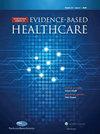Platelet-Rich Fibrin for treating temporomandibular disorders in adults: a Scoping Review protocol
Q3 Medicine
International Journal of Evidence-Based Healthcare
Pub Date : 2022-03-18
DOI:10.17267/2675-021xevidence.2022.e4165
引用次数: 0
Abstract
INTRODUCTION: Different biologically active products have been applied for management of pain and mandibular functional disability in intra-articular TMD but without the ability to effectively control degenerative joint disease. Platelet concentrates aim to enhance tissue healing and facilitate its regeneration. Intra-articular injections of liquid Platelet-Rich Fibrin (PRF) in patients with TMD have demonstrated effectiveness in the management of pain and dysfunction, also having a stimulatory effect on cartilage and bone tissues. OBJECTIVE: The objective of this review is to examine how research has been conducted regarding use of PRF as a treatment tool for temporomandibular joint disorders (TMD). INCLUSION CRITERIA: This review will focus on studies that address adults with TMD without restrictions on gender or ethnicity. TMD will be classified according to the Diagnostic Criteria for Temporomandibular Disorders (DC/TMD) physical axis (Axis I). Also, we will include publications in any language or date of publication. METHODS: This protocol will follow the JBI guidance for Scoping Reviews. We shall conduct a literature search to identify published research, with no limits on year of publication/conception, format, or language. Two independent reviews will screen and select publications, based on inclusion criteria. Review decision process will be provided in a flowchart based on Preferred Reporting Items for Systematic Reviews and Meta-Analyses (PRISMA) recommendations for Scoping Reviews. Finally, we shall present extracted data from each study in piloted forms in conceptual categories such as intervention type, population and sample size, duration of intervention, aims, methodology adopted, key findings and gaps in the research.富血小板纤维蛋白治疗成人颞下颌紊乱:一项范围审查方案
不同的生物活性产品已被应用于关节内TMD的疼痛和下颌功能障碍的管理,但没有能力有效地控制退行性关节疾病。血小板浓缩物的目的是促进组织愈合和促进其再生。在TMD患者关节内注射液体富血小板纤维蛋白(PRF)已被证明对疼痛和功能障碍的管理有效,也对软骨和骨组织有刺激作用。目的:本综述的目的是研究如何将PRF作为颞下颌关节疾病(TMD)的治疗工具进行研究。纳入标准:本综述将重点关注无性别或种族限制的成人TMD研究。TMD将根据颞下颌疾病诊断标准(DC/TMD)物理轴(轴I)进行分类。此外,我们将包括任何语言或出版日期的出版物。方法:本方案将遵循JBI范围审查指南。我们将进行文献检索,以确定已发表的研究,没有出版年份/概念、格式或语言的限制。两个独立的评审将根据纳入标准筛选和选择出版物。评审决策过程将以基于系统评审和荟萃分析(PRISMA)范围评审建议的首选报告项目的流程图提供。最后,我们将以试点形式展示从每项研究中提取的数据,这些数据包括干预类型、人口和样本量、干预持续时间、目标、采用的方法、主要发现和研究中的差距。
本文章由计算机程序翻译,如有差异,请以英文原文为准。
求助全文
约1分钟内获得全文
求助全文
来源期刊

International Journal of Evidence-Based Healthcare
Medicine-Health Policy
CiteScore
1.80
自引率
0.00%
发文量
39
期刊介绍:
The International Journal of Evidence-Based Healthcare is the official journal of the Joanna Briggs Institute. It is a fully refereed journal that publishes manuscripts relating to evidence-based medicine and evidence-based practice. It publishes papers containing reliable evidence to assist health professionals in their evaluation and decision-making, and to inform health professionals, students and researchers of outcomes, debates and developments in evidence-based medicine and healthcare.
The journal provides a unique home for publication of systematic reviews (quantitative, qualitative, mixed methods, economic, scoping and prevalence) and implementation projects including the synthesis, transfer and utilisation of evidence in clinical practice. Original scholarly work relating to the synthesis (translation science), transfer (distribution) and utilization (implementation science and evaluation) of evidence to inform multidisciplinary healthcare practice is considered for publication. The journal also publishes original scholarly commentary pieces relating to the generation and synthesis of evidence for practice and quality improvement, the use and evaluation of evidence in practice, and the process of conducting systematic reviews (methodology) which covers quantitative, qualitative, mixed methods, economic, scoping and prevalence methods. In addition, the journal’s content includes implementation projects including the transfer and utilisation of evidence in clinical practice as well as providing a forum for the debate of issues surrounding evidence-based healthcare.
 求助内容:
求助内容: 应助结果提醒方式:
应助结果提醒方式:


